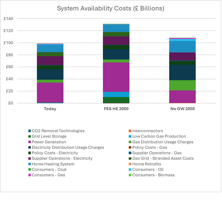The costs of a future energy system are hotly debated, are we looking in the wrong place? Do all...
What Does a General Election mean for the future of the UK's Gas Networks?
As the UK approaches a general election, the future of its gas networks remains uncertain. Some authorities argue against heating homes with low-carbon gas, while others support a blend of heat pumps and low-carbon gas boilers. Low carbon gas is gas as you know it just made a different way so as to meet Net Zero; - hydrogen and biomethane for example.
Politicians from all sides will need help to unravel the complexities involved, it is not an easy answer, why not join in the debate.
For example, one of the UK energy system operators’ (ESO) System Transformation Future Energy Scenario, evaluates this latter approach. At Tranzparent, we’ve been exploring how to analyse this issue, and we’re excited to share our insights as the new parliament forms its energy policies.
Our Investigation
We’re investigating the following question:
How expensive is an energy system in 2050 that works without Natural Gas?
To do this we will compare a System Transformation scenario model which assumes that most of the low carbon gas will be Hydrogen, which in turn is made from a roughly equal mix of Blue (made from Natural Gas) and Green (made from renewable energy) Hydrogen, with a model that only uses Green Hydrogen. Both models have nuclear and other stuff as well.
Key Comparisons
- Whole Energy System Cost
We analyse the generation costs, heating system costs as well as the cost of partially decommissioning the gas network alongside many other costs. We aim to compare apples with apples, both models should stand up to the same stress tests for example.
- Whole Energy System Emissions
We report the emissions in the Climate Change Committee format for those elements affected by the energy system choices made.
Additional Factors to Consider
- System Resilience: How reliable is the model under stress? Specifically, we’ll test the model’s ability to handle a ‘Dunkelflaute’—a period in January with significantly reduced wind levels (down to 50% or even 25% of a normal year) a term coined in Germany and now widely adopted. This means analysing two to three weeks of minimal wind.
- Imported Natural Gas Concerns: We won’t analyse this directly, but we might conduct a LinkedIn poll to gauge public opinion on how much extra you would be willing to pay for a UK energy system independent of gas imports.
- Least regrets: did we regret blowing up all our coal stations when Putin invaded, maybe, they would have been mighty useful. The plan for Net Zero needs to be just and affordable we will hear a lot about that as the election looms, but what is behind the words?
Initial Results
Tranzparent analyses all energy vectors, electricity, hydrogen, biomass, oil, coal, natural gas etc. Here are some charts from the electricity vector. We cannot explain it all in one blog, more will follow preferably led by your questions. The examples below are work in progress and shown as illustration only, they come from our tranzparent online energy model.
 ESO System Transformation in 2050 - working well
ESO System Transformation in 2050 - working well
This first chart illustrates the role of wind in the system and how it handles varying demand. Here the model show a system that operates normally with sufficient generation.

ESO System Transformation in 2050 - Dunkelflaute
This second chart shows the impact of a 25% Dunkelflaute scenario. It reveals gaps where the model fails, causing power outages during both peak and off-peak times. Despite efforts to manage demand, more generation is needed. We'll next look at adding standby generation to meet this stress test, which will increase system costs.
The font is a bit small and the colours don’t match (working on that) but clearly this is a model that is showing the lights out, we have extensive blackouts.
Where We’re Headed
Our goal is to create a comparison table showing the different costs of each model depending on the Dunkelflaute levels applied. All models will likely achieve Net Zero emissions, you can then vote on your preferred system.
Understanding Tranzparent’s Role
Tranzparent is a user-friendly, low-cost, whole energy system model. If you want to conduct your own analysis using our model, please reach out to us—we’re happy to assist. We will hold webinars to discuss the emerging results, come and join in the debate.
Get Involved
Contact us at our website (https://www.tranzparent.energy/ ) or email us at support@tranzparent.energy . We look forward to your participation and feedback.



